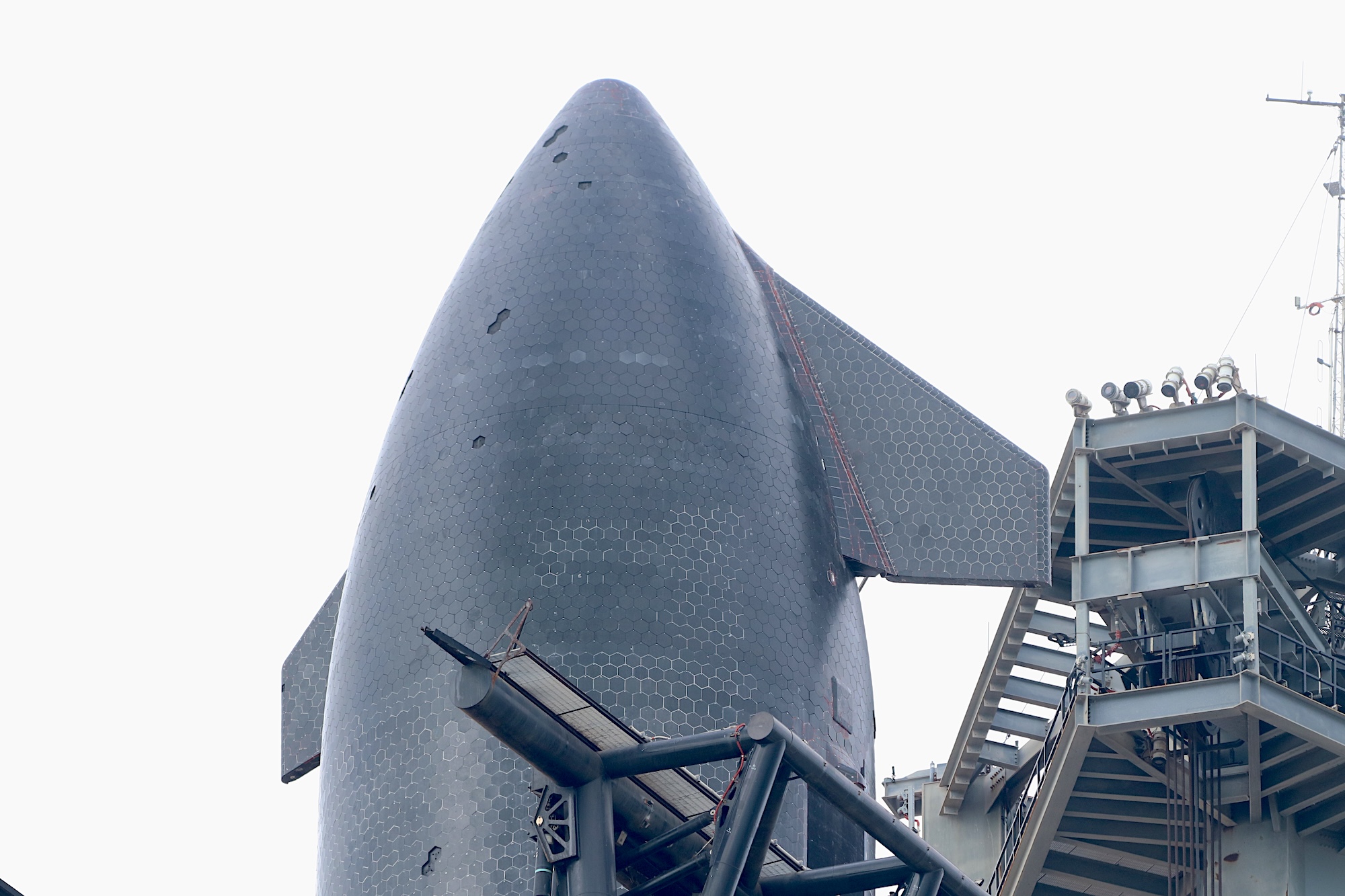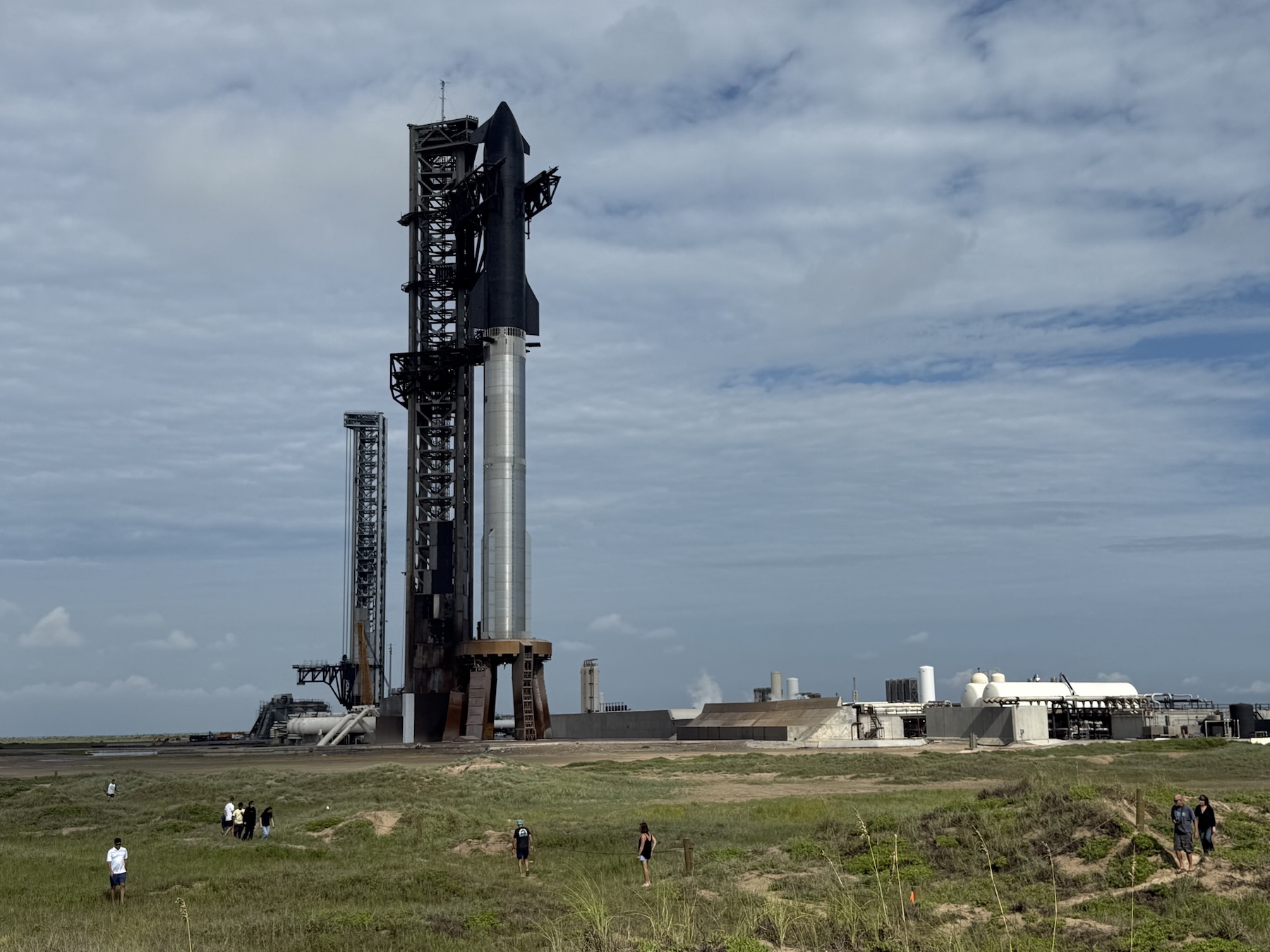SpaceX is gearing up for another Starship launch after three straight disappointing test flights.
SpaceX’s 10th Starship rocket awaits liftoff. Credit: Stephen Clark/Ars Technica
STARBASE, Texas—A beehive of aerospace technicians, construction workers, and spaceflight fans descended on South Texas this weekend in advance of the next test flight of SpaceX’s gigantic Starship rocket, the largest vehicle of its kind ever built.
Towering 404 feet (123.1 meters) tall, the rocket will lift off during a one-hour launch window beginning at 6:30 pm CDT (7:30 pm EDT; 23:30 UTC) Sunday. The main concern for Sunday’s launch attempt will be weather conditions at Starbase, located a few miles north of the US-Mexico border. There’s just a 45 percent chance of favorable weather for liftoff Sunday, according to SpaceX.
It will take about 66 minutes for the rocket to travel from the launch pad in Texas to a splashdown zone in the Indian Ocean northwest of Australia. You can watch the test flight live on SpaceX’s official website. We’ve also embedded a live stream from Spaceflight Now and LabPadre below.
This will be the 10th full-scale test flight of Starship and its Super Heavy booster stage. It’s the fourth flight of an upgraded version of Starship conceived as a stepping stone to a more reliable, heavier-duty version of the rocket designed to carry up to 150 metric tons, or some 330,000 pounds, of cargo to pretty much anywhere in the inner part of our Solar System.
But this iteration of Starship, known as Block 2 or Version 2, has been anything but reliable. After reeling off a series of increasingly successful flights last year with the first-generation Starship and Super Heavy booster, SpaceX has encountered repeated setbacks since debuting Starship Version 2 in January.
Now, there are just two Starship Version 2s left to fly, including the vehicle poised for launch Sunday. Then, SpaceX will move on to Version 3, the design intended to go all the way to low-Earth orbit, where it can be refueled for longer expeditions into deep space.

A closer look at the top of SpaceX’s Starship rocket, tail number Ship 37, showing some of the different configurations of heat shield tiles SpaceX wants to test on this flight. Credit: Stephen Clark/Ars Technica
Starship’s promised cargo capacity is unparalleled in the history of rocketry. The privately-developed rocket’s enormous size, coupled with SpaceX’s plan to make it fully reusable, could enable cargo and human missions to the Moon and Mars. SpaceX’s most conspicuous contract for Starship is with NASA, which plans to use a version of the ship as a human-rated Moon lander for the agency’s Artemis program. With this contract, Starship is central to the US government’s plans to try to beat China back to the Moon.
Closer to home, SpaceX intends to use Starship to haul massive loads of more powerful Starlink Internet satellites into low-Earth orbit. The US military is interested in using Starship for a range of national security missions, some of which could scarcely be imagined just a few years ago. SpaceX wants its factory to churn out a Starship rocket every day, approximately the same rate Boeing builds its workhorse 737 passenger jets.
Starship, of course, is immeasurably more complex than an airliner, and it sees temperature extremes, aerodynamic loads, and vibrations that would destroy a commercial airplane.
For any of this to become reality, SpaceX needs to begin ticking off a lengthy to-do list of technical milestones. The interim objectives include things like catching and reusing Starships, in-orbit ship-to-ship refueling, and finally long-duration spaceflight to reach the Moon and stay there for weeks, months, or years. For a time late last year, it appeared as if SpaceX might be on track to reach at least the first two of these milestones by now.

The 404-foot-tall (123-meter) Starship rocket and Super Heavy booster stand on SpaceX’s launch pad. In the foreground, there are empty loading docks where tanker trucks deliver propellants and other gases to the launch site. Credit: Stephen Clark/Ars Technica
Instead, SpaceX’s schedule for catching and reusing Starships, and refueling ships in orbit, has slipped well into next year. A Moon landing is probably at least several years away. And a touchdown on Mars? Maybe in the 2030s. Before Starship can sniff those milestones, engineers must get the rocket to survive from liftoff through splashdown. This would confirm recent changes made to the ship’s heat shield work as expected.
Three test flights attempting to do just this ended prematurely in January, March, and May. These failures prevented SpaceX from gathering data on several different tile designs, including insulators made of ceramic and metallic materials, and a tile with “active cooling” to fortify the craft as it reenters the atmosphere.
The heat shield is supposed to protect the rocket’s stainless steel skin from temperatures reaching 2,600° Fahrenheit (1,430° Celsius). During last year’s test flights, it worked well enough for Starship to guide itself to an on-target controlled splashdown in the Indian Ocean, halfway around the world from SpaceX’s launch site in Starbase, Texas.
But the ship lost some of its tiles during each flight last year, causing damage to the ship’s underlying structure. While this wasn’t bad enough to prevent the vehicle from reaching the ocean intact, it would cause difficulties in refurbishing the rocket for another flight. Eventually, SpaceX wants to catch Starships returning from space with giant robotic arms back at the launch pad. The vision, according to SpaceX founder and CEO Elon Musk, is to recover the ship, quickly mount it on another booster, refuel it, and launch it again.
If SpaceX can accomplish this, the ship must return from space with its heat shield in pristine condition. The evidence from last year’s test flights showed engineers had a long way to go for that to happen.

Visitors survey the landscape at Starbase, Texas, where industry and nature collide. Credit: Stephen Clark/Ars Technica
The Starship setbacks this year have been caused by problems in the ship’s propulsion and fuel systems. Another Starship exploded on a test stand in June at SpaceX’s sprawling rocket development facility in South Texas. SpaceX engineers identified different causes for each of the failures. You can read about them in our previous story.
Apart from testing the heat shield, the goals for Sunday’s Starship flight include testing an engine-out capability on the Super Heavy booster. Engineers will intentionally disable one of the booster’s Raptor engines used to slow down for landing, and instead use another Raptor engine from the rocket’s middle ring. At liftoff, 33 methane-fueled Raptor engines will power the Super Heavy booster off the pad.
SpaceX won’t try to catch the booster back at the launch pad Sunday, as it did on three occasions late last year and earlier this year. The booster catches have been one of the bright spots for the Starship program as progress on the rocket’s upper stage floundered. SpaceX reused a previously-flown Super Heavy booster for the first time on the most recent Starship launch in May.
The booster landing experiment on Sunday’s flight will happen a few minutes after launch over the Gulf of Mexico east of the Texas coastline. Meanwhile, six Raptor engines will fire until approximately T+plus 9 minutes to accelerate the ship, or upper stage, into space.
The ship is programmed to release eight Starlink satellite simulators from its payload bay in a test of the craft’s payload deployment mechanism. That will be followed by a brief restart of one of the ship’s Raptor engines to adjust its trajectory for reentry, set to begin around 47 minutes into the mission.
If Starship makes it that far, that’ll be when engineers finally get a taste of the heat shield data they were hungry for at the start of the year.
Stephen Clark is a space reporter at Ars Technica, covering private space companies and the world’s space agencies. Stephen writes about the nexus of technology, science, policy, and business on and off the planet.






